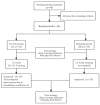Effect of Tai Chi Compared to Running on Drug Cravings, Attention Bias, and Physical Fitness in Men with Methamphetamine Use Disorder
- PMID: 39201211
- PMCID: PMC11353623
- DOI: 10.3390/healthcare12161653
Effect of Tai Chi Compared to Running on Drug Cravings, Attention Bias, and Physical Fitness in Men with Methamphetamine Use Disorder
Abstract
Background: Methamphetamine use disorder (MUD) is a global health problem. Studies have shown Tai Chi is a potential treatment for MUD. We aimed to explore the effectiveness of Tai Chi in improving drug cravings, attention bias, and physical fitness in men with MUD compared with aerobic exercise.
Methods: A total of forty-eight participants (mean age 39.1 ± 8.7 years) were randomly assigned to either the Tai Chi group (TC) or the running group (RG). The TC performed 60 min of moderate-intensity (65-75% HRmax) Tai Chi exercise three times a week. The RG performed 60 min of moderate-intensity (65-75% HRmax) running on a treadmill three times a week. Before and after the intervention, drug cravings, attention bias, and physical fitness were evaluated.
Results: After 12 weeks, we found the TC significantly improved in attention bias (F (1, 43) = 6.023, p = 0.019, d = -0.42) and reaction time (F (1, 43) = 6.181, p = 0.017, d = -0.72). No significant improvement was found in other variables in the TC, compared to the RG (p > 0.05).
Conclusions: The 12-week Tai Chi intervention improved attention bias and reaction time, compared to RG. Tai Chi exercise might be a potential auxiliary method for the rehabilitation for men with MUD.
Keywords: Tai Chi; attention bias; methamphetamine use disorder; physical fitness.
Conflict of interest statement
The authors declare no conflict of interest.
Figures
Similar articles
-
Four-week Tai Chi intervention decreases attention bias to drug cues in individuals with methamphetamine use disorder.Am J Drug Alcohol Abuse. 2021 Sep 3;47(5):638-648. doi: 10.1080/00952990.2021.1950745. Epub 2021 Jul 30. Am J Drug Alcohol Abuse. 2021. PMID: 34325579
-
Effects of Tai Chi on the Executive Function and Physical Fitness of Female Methamphetamine Dependents: A Randomized Controlled Trial.Front Psychiatry. 2021 Jun 10;12:653229. doi: 10.3389/fpsyt.2021.653229. eCollection 2021. Front Psychiatry. 2021. PMID: 34177646 Free PMC article.
-
Effects of Tai-Chi and Running Exercises on Cardiorespiratory Fitness and Biomarkers in Sedentary Middle-Aged Males: A 24-Week Supervised Training Study.Biology (Basel). 2022 Feb 26;11(3):375. doi: 10.3390/biology11030375. Biology (Basel). 2022. PMID: 35336749 Free PMC article.
-
Effects of the different Tai Chi exercise cycles on patients with essential hypertension: A systematic review and meta-analysis.Front Cardiovasc Med. 2023 Mar 3;10:1016629. doi: 10.3389/fcvm.2023.1016629. eCollection 2023. Front Cardiovasc Med. 2023. PMID: 36937925 Free PMC article. Review.
-
Tai Chi for rheumatoid arthritis.Cochrane Database Syst Rev. 2019 Sep 25;9(9):CD004849. doi: 10.1002/14651858.CD004849.pub2. Cochrane Database Syst Rev. 2019. PMID: 31553478 Free PMC article.
References
-
- World Drug Report 2022. [(accessed on 3 July 2024)]. Available online: www.unodc.org/unodc/en/data-and-analysis/world-drug-report-2022.html.
Grants and funding
LinkOut - more resources
Full Text Sources





